Jabalpur
Jabalpur (English: /ˌdʒʌbəlˈpʊər/, US also /ˈdʒʌbəlˌpʊər/, Hindi: [dʒəbəlˈpʊɾ]; formerly known as Jubbulpore, the official spelling until 2006) is a tier 2 city in the Indian state of Madhya Pradesh. It is one of the major cities of Madhya Pradesh. According to the 2011 census, it is the third-largest urban agglomeration in Madhya Pradesh, and the country's 38th-largest urban agglomeration.[3] It is known for the Dhuandhar Falls and the white Marble Rocks at Bhedaghat. It is generally accepted that the game of Snooker originated here.[6]
Jabalpur Jubbulpore | |
|---|---|
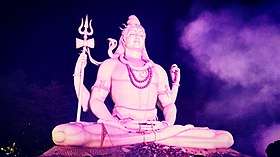  's_Admin_Building.jpg)  From top: Shiva temple kachnar city, MP High Court, Jabalpur Engineering College & Dhuandhar Waterfall | |
| Nickname(s): Sanskaar Dhaani, Tripur Tirth | |
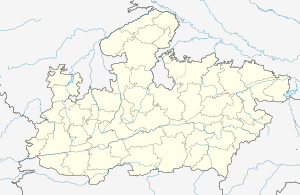 Jabalpur Location of Jabalpur in India  Jabalpur Jabalpur (India) | |
| Coordinates: 23°10′N 79°56′E | |
| Country | India |
| State | Madhya Pradesh |
| District | Jabalpur |
| Government | |
| • Type | Mayor–Council |
| • Body | Jabalpur Municipal Corporation |
| • Mayor | Swati Godbole |
| • District Magistrate | Bharat Yadav |
| • Municipal commissioner | Chandramauli Shukla |
| • MP | Rakesh Singh |
| Area | |
| • Metropolis | 374 km2 (144 sq mi) |
| Elevation | 412 m (1,352 ft) |
| Population | |
| • Metropolis | 1,267,564 |
| • Rank | 37th |
| • Density | 3,390/km2 (8,800/sq mi) |
| • Metro | 1,444,667 |
| • Metro rank | 37th |
| Demonym(s) | Jabalpurians, Jabalpuriya, Jabalpurites |
| Time zone | UTC+5:30 (IST) |
| PIN | 482001 to 482011 |
| Telephone code | +91-761 |
| ISO 3166 code | IN-MP |
| Vehicle registration | MP-20 |
| Sex ratio | 929 ♂/♀ |
| Average Literacy Rate | 82.13% |
| Official language | Hindi[5] |
Jabalpur is an important administrative, industrial, and business center of Madhya Pradesh. It is a major education hub in India. The High Court of Madhya Pradesh and several departmental headquarters of the State Government are located in Jabalpur. The city has a major military base and has four major Indian Ordnance Factories for the production of arms and ammunition in India, which are the city's primary source of employment. It also has several other smaller industries. The city is a major trading center and producer of forest products, experiencing fast growth in all sectors.
Jabalpur is the administrative headquarters of Jabalpur district (the second-most-populous district in Madhya Pradesh) and the Jabalpur division. Historically, a center of the Kalachuri and Rajgond dynasties, the city developed a syncretic culture influenced by intermittent Mughal and Maratha reigns.
During the early nineteenth century, it was annexed by British India and renamed as Jubbulpore and incorporated as a cantonment town. Since Indian independence there have been demands for a separate state of Mahakoshal, with Jabalpur its capital. The headquarters of the West Central Railway, Madhya Pradesh Electricity Board, Tropical Forest Research Institute (TFRI), and Army headquarters of five states, viz. Madhya Pradesh, Chhattisgarh, Orissa, Bihar and Jharkhand, are in Jabalpur. Jabalpur is also the Army Headquarters for The Grenadiers and Jammu and Kashmir Rifles regiments. The city is also the headquarter of 1 Signal Training Centre.
Etymology
According to a prevalent theory, Jabalpur was named after a sage named Jabali, who meditated on the banks of the Narmada river. Another theory suggests an Arabic origin of the word since jabal in Arabic means granite boulders or huge boulders, which were common in the region. According to a fringe theory, the name refers to Jauli Pattala, a sub-divisional unit, mentioned in Kalachuri inscriptions. Jauli also refers to the Huna queen of the Kalachuri king, Karna. It was spelled as Jubbulpore during British rule.[7]
In 2006, the Jabalpur Municipal Corporation renamed the city to Jabalpur.[8]
History
Mythology describes three Asuras (evil spirits) in the Jabalpur region, who were defeated by the Hindu god Shiva. Tripurasura being the main asura, gave the city its puranic name Tripur Tirth.[9] Tripuri region corresponds to the ancient Chedi Kingdom of Mahabharata times, to which king Shishupala belongs.
Ashokan relics dating to 300 BCE have been found in Rupnath, 84 kilometres (52 mi) north of the city, indicating the presence of the Mauryan Empire (322 to 185 BCE) in the region.[9] When the empire fell, Jabalpur became a city-state before coming under the rule of the Satavahana dynasty (230 BCE to 220 CE). After their reign, the region was ruled locally by the Bodhis and the Senas, following which it became a vassal state of the Gupta Empire (320 to 550).[9]
From 675 to 800, the region was ruled by Bamraj Dev of the Kalachuri Dynasty from Karanbel. The best known Kalachuri ruler was Yuvraj Dev I (r. 915–945), who married Nohla Devi (a princess of the Chalukya dynasty). One of the Kalachuri ministers, Golok Simha Kayastha, was instrumental in founding the Chausath Yogini Temple near Bhedaghat. His descendants include Bhoj Simha, who was the Dewan to Sangramsahi (r. 1491–1543); Dewan Adhar Simha, who was the prime minister to Rani Durgavati (r. 1550–1564), and Beohar Raghuvir Sinha, the last Jagirdar of Jabalpur who reigned until 1947.
Gondwana rule
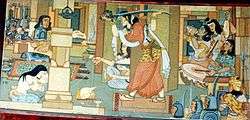
The Gondwana king, Raje Madan Shah Madawi of Mandla, (r. 1138–1157) built a watchtower and a small hilltop fort at Madan Mahal, an area in Jabalpur. In the 1500s, the Gond king, Sangram (whose son, Raje Dalpat Shah Madawi married Rani Durgavati) held Singaurgarh fort in Sangrampur. Rani Durgawati was a warrior of the Gond Dynasty, famous for her prosperous kingdom. She was well aware of the importance of water conservation and hence she built more than 85 ponds in Jabalpur, mainly Ranital, Haathital, Madhatal and Hanumantal.[10]
In 1564, during the reign of Veer Narayan (Sangram's grandson), Abdul Majeed Harawi (viceroy of Kara-Manikpur in the Mughal Empire) conquered Jabalpur and its surrounding areas. However, the Mughal supremacy in Jabalpur was more nominal than real.
In 1698, the Gondwana king, Raje Hriday Shah (r. 1652–1704) moved his court to the Mandla fort. He secured water sources and built irrigation structures. Later, Gondwana was seized by Nizam (r. 1753–1780). After Nizam, the Gondwana Kingdom was conquered by the Marathas.
Maratha rule
The Maratha rulers of Sagar, came to power in about 1781. Around 1798, the Maratha Peshwa gave the Nerbuddah valley to the Bhonsle kings of Nagpur, who ruled the area until 1818, when it was seized by the British East India Company after the Battle of Sitabuldi.
British Raj
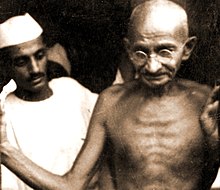
Under the British Raj, the name Jabbalgarh became Jubbulpore and the town was made the capital of the Saugor and Nerbudda Territories (part of the North-Western Provinces governed by the Agra Presidency). Jabalpur was known for Thuggee murders, which were combated by William Henry Sleeman (later appointed as the chief commissioner at Jubbulpore and then British Resident at Lucknow). 16 June 1857 saw the kindling of a rebellion in the cantonment of Jubbulpore. The 1857 movement was started by the Gondwana king, Raje Shankar Shah Madawi and the prince Kunwar Raghunath Shah Madawi. Both were arrested and imprisoned, and executed on 18 September 1857.
In 1861, the Saugor and Nerbudda Territories became part of the new Central Provinces and in 1903, the Central Provinces and Berar. In the early 1900s, Jubbulpore became the headquarters of a brigade of the Fifth Division of the Southern Army. A gun carriage factory was established in Jabalpur in 1904.
Mahatma Gandhi's longest stay in Jubbulpore was in 1933 at the Beohar palace of Beohar Rajendra Simha. Many freedom fighters joined Gandhi's Swadeshi, Swaraj and Satyagraha movements. Those from Jubbulpore included Ravishankar Shukla, Seth Govind Das, Subhadra Kumari Chauhan, Makhanlal Chaturvedi and Dwarka Prasad Mishra.
In 1939, the Tripuri Indian National Congress (INC) session was chaired by Subhas Chandra Bose. The Swaraj movement begun under the direction of Lokmanya Tilak. A Congress session was held at Vishnudatt Shukla Nagar at Tilwara Ghat, near Jubbulpore, when Subhas Chandra Bose was elected the Congress President over Gandhi's objections.
After independence
Gandhi's remains were brought to the city after his death. On 12 February 1948, the urn containing his ashes was immersed in the Narmada River at Tilwara Ghat by Ravishankar Shukla, Beohar Rajendra Sinha, Seth Govind Das, and others.
In 1950, the Central Provinces and Berar became the state of Madhya Pradesh and Shukla became the first chief minister of the Congress-led government. In 1956, Madhya Bharat, Vindhya Pradesh and Bhopal (state) were merged into the newly formed state of Madhya Pradesh.
Geography
India's central point is in the Jabalpur district. The city has an average elevation of 411 metres (1,348 feet). The Narmada river passes by this city, which is surrounded by temples and ghats for the visitors. Jabalpur's hills, with their variety of minerals, draw geologists and archaeologists. The city is surrounded by low, rocky, and barren hillocks. Its primary reservoirs, namely, Khandari and Pariyat are in the northeast areas of the city, and water is also drawn from the Narmada River by the public health department.
The main crops grown in the region are wheat, rice, pulses, oilseeds and maize. Bargi Dam, on the Narmada, is used for irrigation, water, and power generation. The area is rich in limestone, refractory clay, bauxite, iron ore, manganese and other deposits with some mineral-related industries located in the area.
Climate
| Jabalpur | ||||||||||||||||||||||||||||||||||||||||||||||||||||||||||||
|---|---|---|---|---|---|---|---|---|---|---|---|---|---|---|---|---|---|---|---|---|---|---|---|---|---|---|---|---|---|---|---|---|---|---|---|---|---|---|---|---|---|---|---|---|---|---|---|---|---|---|---|---|---|---|---|---|---|---|---|---|
| Climate chart (explanation) | ||||||||||||||||||||||||||||||||||||||||||||||||||||||||||||
| ||||||||||||||||||||||||||||||||||||||||||||||||||||||||||||
| ||||||||||||||||||||||||||||||||||||||||||||||||||||||||||||
Jabalpur has a humid subtropical climate typical of north-central India (Madhya Pradesh and southern Uttar Pradesh). Summer begins in late March, lasting until June. May is the hottest month, with the average temperature exceeding 45 °C (113 °F). Summer is followed by the southwest monsoon, which lasts until early October and produces 889 mm (35 in) of rain from July to September. Average annual precipitation is nearly 1,386 mm (54.6 in). Winter begins in late November, and lasts until early March. January is the coldest month, with an average daily temperature near 15 °C (59 °F).
| Climate data for Jabalpur | |||||||||||||
|---|---|---|---|---|---|---|---|---|---|---|---|---|---|
| Month | Jan | Feb | Mar | Apr | May | Jun | Jul | Aug | Sep | Oct | Nov | Dec | Year |
| Average high °C (°F) | 24.5 (76.1) |
28.8 (83.8) |
34.3 (93.7) |
38.7 (101.7) |
40.4 (104.7) |
36.2 (97.2) |
30.3 (86.5) |
28.2 (82.8) |
30.9 (87.6) |
32.4 (90.3) |
29.7 (85.5) |
25.5 (77.9) |
31.7 (89.0) |
| Average low °C (°F) | 8.5 (47.3) |
11.4 (52.5) |
16.2 (61.2) |
21.2 (70.2) |
24.4 (75.9) |
24.1 (75.4) |
22.6 (72.7) |
21.9 (71.4) |
21.1 (70.0) |
18.1 (64.6) |
13.9 (57.0) |
9.6 (49.3) |
17.7 (64.0) |
| Average precipitation mm (inches) | 22.2 (0.87) |
23.4 (0.92) |
15.5 (0.61) |
7.7 (0.30) |
12.9 (0.51) |
167.3 (6.59) |
421.9 (16.61) |
422.9 (16.65) |
200.1 (7.88) |
39.9 (1.57) |
15.0 (0.59) |
9.9 (0.39) |
1,358.7 (53.49) |
| Average precipitation days | 0.8 | 0.8 | 0.3 | 0.3 | 1.8 | 8.6 | 15.9 | 18.3 | 8.6 | 3.1 | 1.4 | 0.6 | 60.5 |
| Mean monthly sunshine hours | 288.3 | 274.4 | 288.3 | 306.0 | 325.5 | 210.0 | 105.4 | 80.6 | 180.0 | 269.7 | 273.0 | 282.1 | 2,883.3 |
| Source: HKO | |||||||||||||
Demographics
| Year | Population |
|---|---|
| 2011 | 1,268,848 |
| 2012 | 1,295,000 |
| 2013 | 1,320,000 |
| 2014 | 1,360,000 |
| 2015 | 1,385,000 |
| 2016 | 1,400,000 |
| 2017 | 1,440,000 |
| 2018 | 1,450,000 |
In the 2011 India census, the Jabalpur city (the area covered by the municipal corporation) recorded a population of 1,081,677.[2] The Jabalpur metropolitan area (urban agglomeration) recorded a population of 1,268,848.[3]
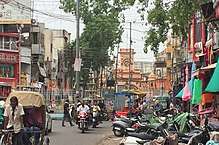
Economy
Agriculture
The Narmada River, draining the Satpura and Vindhya Ranges, has helped to develop an agrarian economy in the district. The river originates in the northeastern Satpura Range and flows west, between the ranges towards the Arabian Sea. The Narmada basin's alluvial soil helps in producing sorghum, wheat, rice, and millet in the villages around Jabalpur.
Commercial crops include pulses, oilseeds, cotton, sugar cane, and medicinal crops. During the early 20th century the region became a center of the beedi industry, when two brothers, Mohanlal and Hargovindas Patel discovered that tendu leaves were good for making beedies.
Industry
Major industries in Jabalpur are garment manufacturing, information technology, education, electrical goods, limestone products, building materials, glassware, telephone parts, furniture, foodstuffs, steel structures, cement, tobacco products, industrial-safety goods, mechanical engineering and cinema. The city is also a big manufacturing hub of Salwar suits (a type of female clothes). A garment cluster has also been established to give a common roof to all manufacturers. A Techno Park has been established at Bargi hills to give a conducive environment for IT companies.
Information technology & Park
M.P. State Electronics Development Corporation Ltd. has setup an I.T. park (Techno Park)[13] in Bargi Hills having total area of 60 acres, 22KM from the Jabalpur airport.Paytm started their operations at Jabalpur in 2018.[14]
Indian Ordnance Factories
's_Matang_Truck_for_the_Indian_Army.jpg)
Vehicle Factory Jabalpur, Grey Iron Foundry, Gun Carriage Factory Jabalpur, and the Ordnance Factory Khamaria belonging to the Ordnance Factory Board manufacture bullets, howitzers, missiles, rockets, bombs, mines, mortars, grenades, shells, trucks, mine-protected vehicles and bulletproof vehicles for the Indian Armed Forces, the paramilitary forces of India, the Central Armed Police Forces, State Armed Police Forces and the Special Forces of India. These companies are the city's primary employers. Allied organisations are the Directorate General of Quality Assurance (DGQA), responsible for the inspection of quality of equipment manufactured by the ordnance factories; the Central Ordnance Depot, which stores and supplies equipment and weapons for the armed forces; the 506 Army Base Workshop, which maintains equipment for the armed forces and the Defence Security Corps, responsible for guarding the ordnance factories. These organisations alone employ over 100,000 people.
Government and public services
Civic administration
In 2011, Jabalpur covered an area of 53 square kilometres (20 sq mi). The Jabalpur municipal corporation, the JMC, is charged with governance of the city's civic and infrastructural assets. The corporation has two wings: deliberative and executive. The head of the executive wing is a municipal commissioner who is responsible for the corporation's day-to-day operation and assists the deliberative wing in the decision-making process. The JMC council has one elected representative (corporate) from each ward. Council elections, by popular vote, are held every five years. A corporate from the majority party is selected as mayor.
Jabalpur contributes one member to the Lok Sabha. Rakesh Singh of Bharatiya Janata Party had been elected as the Member of Parliament in the 2019 Lok Sabha election.[15] The city sends eight members to the State Legislative Assembly: four from the city (Jabalpur Purba, Jabalpur Uttar, Jabalpur Cantonment and Jabalpur Paschim) and four from rural areas of the district. Jabalpur is divided into eight zones, each consisting of several wards.
Division headquarters
Jabalpur is the divisional headquarters for eight districts: Jabalpur, Seoni, Mandla, Chhindwara, Narsinghpur, Katni, Dindori and Balaghat. The district, which was reconstituted on 25 May 1998, has four tehsils: Jabalpur, Sihora, Patan and Kundam. The city is the headquarters of the Madhya Pradesh State Electricity Board, the Home-guards and other state and central-government offices.
Military establishments
The Jabalpur Cantonment is one of the largest cantonments in India.[16] In addition to the ordnance factories, other organisations present in the city include HQ Madhya Bharat Area, the Jammu & Kashmir Rifles Regimental Centre, the Grenadiers Regimental Centre, 1 Signal Training Centre, College of Material Management, Central Ordnance Depot, 506 Army Base Workshop, Military Hospital, HQ Chief Engineer Jabalpur Zone, Military Dairy Farm, and HQ Recruiting Zone. Civilian organisations which are part of the Ministry of Defence are the Cantonment Board, Controller of Defence Accounts, Defence Standardisation Cell and the Canteen Stores Department.
Culture
Jabalpur has been called the Sanskaar Dhani or the cultural capital of Madhya Pradesh by Vinayak Narhari Bhave. Cultural figures associated with the city include Beohar Rammanohar Sinha, Makhanlal Chaturvedi, Harishankar Parsai, Beohar Rajendra Singh, Subhadrakumari Chauhan, Kavi Indra Bahadur Khare, Seth Govind Das, Roopkumar Soni, Alakhnandan Sinha, Arun Shukla, Gyanranjan Shrivastava, Rehman, Prem Nath, Krishna Raj Kapoor, Kiran Kher, Arjun Rampal, Jaya Bachchan, Aadesh Shrivastava, Raghubir Yadav and Shalini Pandey.
The Narmada River, Gondwana rule and the Kalachuri and Maratha dynasties made Jabalpur a Gondism and Hinduism-dominated area, although Mughal rule attracted a sizeable Muslim population.
Jabalpur's culture is related to the agricultural population of the city and surrounding areas. Food and clothing change with the harvest and season. The city has sizeable population of Gonds, Marwari, Bengali, Malayali, Sindhi, Tamil, Telugu, Kannadiga, Marathi, Punjabi people and Baniya people. The Navratri and Dusshera festivals are celebrated by residents and visitors from across the state.
Cuisine
Sweets in Jabalpur's local delicacy include Doodh ka Halwa, Kalakand, Bhaji Wada, Dal Mangode, Aloo Bonda, Khoye ki Jalebi,[17] Mawa-Bati, Khoprapak, Shrikhand, Malpua, Imarti and Makkhanvada.[18] Khoye ki Jalebi, which is quite popular in Madhya Pradesh,[18] was invented by Harprasad Badkul in 1889 at his shop, Badkul Halwai.[19][20][21]
Tourism
Jabalpur is an important tourism city in Madhya Pradesh and central India. Notable sites in Jabalpur include Hanumantal Bada Jain Mandir, Madan Mahal, Dhuandhar Falls, Chausta -Yogini, various ghat and Marble Rocks in Bhedaghat, Balancing rock near Madan Mahal Fort and the Shiv Statue at Kachnar City. The world-renowned tiger reserves like Kanha National Park, Bandhavgarh National Park, and Pench National Park can be easily visited via Jabalpur.
Hanumantal Bada Jain Mandir is a 17th-century Jain temple that appears like a fortress with numerous shikharas. The temple has 22 shrines (vedis), making it the largest independent Jain temple in India. Madan Mahala is a fort built by the Gondi king Madansahi in 1116 which is situated atop a hill in Jabalpur. Kachnar city in Jabalpur is known for a 23-metre-high (76 ft) Shiva statue housing a cavern with replicas of Shiva lingas from 12 shrines nationwide.[22] The city also houses the Rani Durgawati Museum which was built in 1964 to commemorate Rani Durgavati. The museum hosts ancient relics, sculptures and a collection of items related to Mahatma Gandhi. Dumna Nature Reserve Park is an ecotourism site open to the public which is located in the Jabalpur district. It houses the Khandari Dam, which is a source of drinking water to the city and has many crocodiles. The Bargi Dam Reservoir near Jabalpur is known for boat rides.
Tourist attractions in Jabalpur also include the boat rides on the Narmada river, which is 15 kilometres (9.3 mi) away from the city, specially in moonlight. The journey through Narmada reveals the Marble Rocks, where the river has carved the soft marble, creating a gorge of about 8 km in length, and the Dhuandhar falls, which is one of the most famous tourist destinations in Jabalpur. Lamheta Ghaat[23] and Tilwara Ghaat[24] are famous Ghats on the banks of Narmada River. The Tilwadeshwar temple is located near the Tilwara Ghat and it is also the place where Gandhi's ashes were immersed.
Other tourist destinations near the city include Chausath Yogini Temple, Bhedaghat Fall,[25] Bhadbhada fall,[26] Gughra Fall,[27] Osho Amritdham,[28] Pisanhari Ki Madiya which is a historic Jain pilgrimage near Netaji Subhash Chandra Bose Medical College,[29] and Nandishwardeep Jain temple.
Transport
Air
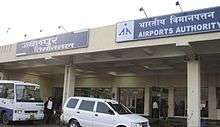
The 130-hectare (310-acre) Jabalpur Airport (JLR), also known as Dumna Airport, is about 20 kilometres (12 mi) away from the city centre and flight services are provided by Alliance Air, Indigo and SpiceJet Daily service is available to New Delhi, Mumbai, Hyderabad, Kolkata and Ahmedabad.
A new Integrated terminal will be built with an area of 9350 m2 and capable of handling 500 passengers at peak hours. The project also includes extending the runway to 2750 meters from the current 1988 meters, a 14 km long boundary wall, a 5 km long approach road connecting airport to the city, ATC control tower cum technical block, apron, taxiway, isolation bay and a fire station. The foundation stone was laid on 13 August 2018 by Suresh Prabhu, Jayant Sinha, Rakesh Singh amongst others.
Rail
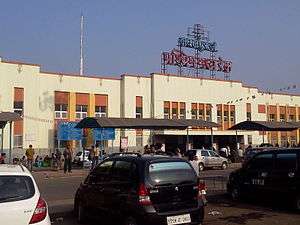
Jabalpur Junction railway station, headquarters of the West Central Railway, has direct service to Mumbai, New Delhi, Chennai, Kolkata, Ahmedabad, Hyderabad, Bangalore, Nagpur, Surat, Pune, Patna, Ludhiana, Jammu, Vasco-Da Gama, Amravati, Coimbatore, Bhopal, Indore, Gwalior, Agra, Mathura, Jaipur, Varanasi, Kanpur, Vadodara, Bhubhaneshwar, Lucknow, Puri, Allahabad, Nashik, Rajkot, Guwahati, Ambikapur, Bilaspur, Tatanagar, Raipur, Haridwar, Rameshwaram, Coimbatore, Visakhapatnam, Vijayawada, and Trivandrum.
The line from Gondia to Balaghat and Jabalpur to Nainpur has been converted to broad gauge with daily passenger services.
Jabalpur was the terminus of Indian Railways train number 1: the Satpura Express, re-numbered Train No. 10001 in the five-digit numbering system. This train stopped service due to the upgrade to broad gauge.
In addition to the Jabalpur Main Station, the city's Madan Mahal Station serves inner-city passengers, and the Kachhpura goods shed transports heavy freight and iron ore to port cities. A Jabalpur metro rail project is proposed for the metropolitan area.
Important trains that originate from here :
- 12061/Bhopal Habibganj – Jabalpur Jan Shatabdi Express
- 12121/Madhya Pradesh Sampark Kranti Express
- 12187/Jabalpur – Mumbai CST Garib Rath Express
Road
Jabalpur is connected by road to Varanasi, Nagpur, Bhopal, Jaipur, Raipur, Allahabad, Hyderabad, Bilaspur and Bangalore. India's longest national highway, National Highway 7, runs through the city, and National Highway 12 to Jaipur originates in Jabalpur. Many roads are being upgraded to four-lane highways. Bus service is available to cities in Madhya Pradesh, Maharashtra and Chhattisgarh, with direct service to Indore, Nagpur, Bhopal, Varanasi, Raipur, Amravati, Chandrapur, and Allahabad.
Education
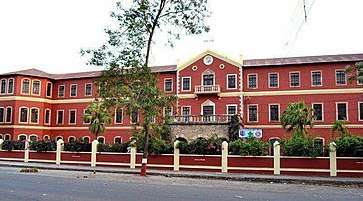
Jabalpur became a centre of higher education by the end of the 19th century, with institutions such as the Hitkarini Sabha, established by local citizens in 1868,[30] and Robertson College (now bifurcated into the Government Science College, Jabalpur, and Mahakoshal Arts & Commerce College) was established in Sagar in 1836 and moved to Jabalpur in 1873.[31] Government Engineering College, Jabalpur was the first technical institution in Central India to be established by the British. IIITDM Jabalpur was founded in 2005. Scholars, authors and politicians such as Ravishankar Shukla, Rajneesh, Maharishi Mahesh Yogi and Gajanan Madhav Muktibodh had been in Jabalpur for some time in their life.
Jabalpur is known for many universities such as Rani Durgavati University (also called the University of Jabalpur), Madhya Pradesh Medical Science University, Jawaharlal Nehru Agricultural University, Nanaji Deshmukh Veterinary Science University and Dharmashastra National Law University, Jabalpur.
Jabalpur also hosts a Government Medical College named Netaji Subhash Chandra Bose Medical College.
Media
Several television news channels have branches in the city. Various cable operators operate digital cable TV system in city.[32]
Newspapers
National and local newspapers are published in Jabalpur in Hindi and English:
| Newspaper | Language | Founded |
|---|---|---|
| Naiduniya | Hindi | 1947 |
| Patrika | Hindi | 2009 |
| Nava Bharat | Hindi | 1934 |
| Deshbandhu | Hindi | 1959 |
| Hari Bhoomi | Hindi | 1996 |
| The Times of India | English | 1838 |
| Hindustan Times | English | 1924 |
| Hindustan | Hindi | |
| The Hitavada | English | 1911 |
| Business Standard | English, Hindi | 1975 |
| Dainik Bhaskar | Hindi | 1958 |
| Yash Bharat | Hindi | 2006 |
Radio
Radio stations in Jabalpur include:
| Name | Frequency (MHz) | Tagline |
| Red FM | 93.5 | Bajaate raho |
| MY FM | 94.3 | Jiyo Dil se! |
| Radio Mirchi | 98.3 | Its Hot! |
| Radio Dhamaal | 106.4 | Dhinchak |
| Akashvani | 102.9 | |
| Gyan Vani | 105.6 |
Akashvani Jabalpur broadcasts on 801 kHz AM with a 200 kW transmitter.
Sports
The city has two stadiums: Wright Town Stadium and Rani Tal Stadium. It is generally accepted that while serving at Jabalpur in 1875, Colonel Sir Neville Chamberlain developed a new variation of black pool by introducing coloured balls into the game in the British Army officer's mess. This game was later dubbed snooker.[6]
Notable people and residents
Historical icons
Movie and TV personalities
- Sharat Saxena
- Gurmeet Choudhary
- Prem Nath
- Jaya Bachchan
- Arjun Rampal
- Kirron Kher
- Shaleen Bhanot
- Raghubir Yadav
- Aadesh Shrivastava
- Ashutosh Rana
- Shalini Pandey
- Tom Alter
Armed Forces Officers
- Admiral Jal Cursetji
- Maj Gen G. D. Bakshi
- Lt Gen WAG Pinto
Civil Servants
Politicians
- K. S. Sudarshan
- Shreegopal Vyas
- Frank Anthony
- Sharad Yadav
- Rakesh Singh
- Rameshwar Neekhra
- Vivek Tankha
Business
Spiritual gurus
- Osho Rajneesh
- Maharshi Mahesh Yogi
- Mahant Swami Maharaj
Journalists
Doctors
Authors and Poets
- Subhadra Kumari Chauhan
- Kamta Prasad Guru
- Harishankar Parsai
- Nell St. John Montague
- Ram Kinkar Upadhyay
See also
- Jabalpur district
- Indian Ordnance Factories
- Tropical Forest Research Institute
References
- "District Census Handbook, Indore" (PDF). Archived (PDF) from the original on 31 May 2016. Retrieved 23 July 2016.
- "Jabalpur district" (PDF). 2011 Census of India. Archived (PDF) from the original on 14 November 2015. Retrieved 20 October 2015.
- "Provisional Population Totals, Census of India 2011; Urban Agglomerations/Cities having population 1 lakh and above" (PDF). Office of the Registrar General & Census Commissioner, India. p. 3. Archived (PDF) from the original on 13 November 2011. Retrieved 26 March 2012.
- "Presentation on Towns and Urban Agglomerations". Census of India 2011. Archived from the original on 14 March 2016. Retrieved 13 March 2016.
- "52nd REPORT OF THE COMMISSIONER FOR LINGUISTIC MINORITIES IN INDIA" (PDF). nclm.nic.in. Ministry of Minority Affairs. Archived from the original (PDF) on 25 May 2017. Retrieved 25 May 2019.
- "The History of Snooker". Titansports.co.uk. Archived from the original on 17 December 2002. Retrieved 1 September 2010.
- "MP Trail: When two Britishers disagreed on the name of Jabalpur". www.telegraphindia.com. 27 November 2018. Retrieved 9 December 2019.
- "Now, Indore to become Indur, Bhopal Bhojpal". The Times of India. 18 December 2006. Archived from the original on 28 October 2009. Retrieved 2 February 2011.
- Jabalpur City Guide. Archived 18 November 2015 at the Wayback Machine Goodearth Publications, 2008 p8. ISBN 9788187780731.
- "Gondwana rulers". Archived from the original on 7 October 2017.
- "Jabalpur District Religion Data - Census 2011". www.census2011.co.in. Archived from the original on 6 September 2018. Retrieved 13 September 2018.
- "Major Agglomerations of the World - Population Statistics and Maps". www.citypopulation.de. Archived from the original on 13 September 2018. Retrieved 13 September 2018.
- "M.P. State Electronics Development Corporation Ltd". MPSEDC.
- "Nai Duniya Newspaper". Nai Duniya Newspaper. Retrieved 26 May 2017.
- "Jabalpur Election Results 2019 Live Updates: Rakesh Singh of BJP Wins". News18. 23 May 2019. Retrieved 23 May 2019.
- "Jabalpur Cantonment Board". Jabalpur Cantonment Board. Archived from the original on 8 April 2014. Retrieved 7 April 2014.
- "7 Must Have Dishes From Madhya Pradesh You Just Cannot Miss". HolidayIQ. Archived from the original on 18 October 2018. Retrieved 18 October 2018.
- "10 Sweets that You can't afford to miss while you're travelling around Madhya Pradesh! - MP Travelogue". MP Travelogue. Archived from the original on 18 October 2018. Retrieved 18 October 2018.
- Siddhantacharya Phulachandra Shastri, Parwar Jain Samaj ka Itihas, 1990, Jabalpur, p. 418
- "Sugar rush: TravelKhana to deliver sweets to train passenger, DNA, 18 Mar 2016". 18 March 2016. Archived from the original on 24 March 2017. Retrieved 29 April 2017.
- "Tasty dishes you must try from these lesser known corners of India". www.msn.com. Archived from the original on 18 October 2018. Retrieved 18 October 2018.
- "Jabalpur". Jabalpur Tourism Promotion Council. Jabalpur Tourism Promotion Council. Archived from the original on 19 April 2014. Retrieved 19 April 2014.
- "Lamheta Ghat". Archived from the original on 19 October 2018. Retrieved 18 October 2018.
- "Tilwara Ghat". Archived from the original on 19 October 2018. Retrieved 18 October 2018.
- "Bhedaghat Water Fall". Archived from the original on 19 October 2018. Retrieved 18 October 2018.
- "Bhadbhada Waterfall". Archived from the original on 19 October 2018. Retrieved 18 October 2018.
- "Ghughra Fall". Archived from the original on 19 October 2018. Retrieved 18 October 2018.
- "Osho Amritdham". Archived from the original on 19 October 2018. Retrieved 18 October 2018.
- "Pisanhari Ki Madiya". jabalpur.nic.in. Office of District Magistrate, Jabalpur, Madhya Pradesh. Archived from the original on 20 January 2016. Retrieved 17 January 2016.
- Allen's Indian mail and register of intelligence for British and foreign India Published 1870
- Madhya Pradesh Through the Ages, edited by Shiri Ram Bakshi, S.R. Bakshi And O.P. Ralhan, p. 20
- "Jabalpur Media". Mapsofindia.com. Archived from the original on 29 June 2011. Retrieved 1 September 2010.
External links
| Wikimedia Commons has media related to Jabalpur. |
| Wikivoyage has a travel guide for Jabalpur. |
| Wikiquote has quotations related to: Jabalpur |
's_Main_Building.jpg)